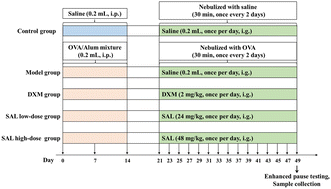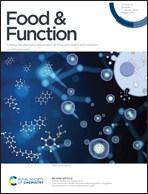Mechanistic study of salidroside on ovalbumin-induced asthmatic model mice based on untargeted metabolomics analysis†
Abstract
Salidroside (SAL) is a natural component derived from Rhodiola rosea and is well known for its wide range of biological activities such as its anti-inflammatory and anti-oxidative properties. However, its effects and mechanisms of action related to asthma have not been well explored yet. Recent studies have found that changes in host metabolism are closely related to the progression of asthma. Many natural components can ameliorate asthma by affecting host metabolism. The use of untargeted metabolomics can allow for a better understanding of the metabolic regulatory mechanisms of herbs on asthma. This study aimed to demonstrate the anti-asthmatic effects and metabolic regulatory mechanisms of SAL. In this study, the therapeutic effects of SAL on asthmatic mice were tested at first. Secondly, the effects of SAL on the airway inflammatory reaction, oxidative stress, and airway remodeling were investigated. Finally, untargeted metabolomics analysis was used to explore the influence of SAL on lung metabolites. The results showed that SAL had a significant therapeutic effect on asthmatic model mice. Moreover, SAL treatment lowered interleukin (IL)-4, IL-5, and IL-13 levels but elevated interferon gamma (IFN-γ) and IL-10 levels in bronchoalveolar lavage fluid (BALF). Additionally, it also increased superoxide dismutase (SOD) and glutathione peroxidase (GSH-Px) activities and decreased methane dicarboxylic aldehyde (MDA) levels in the lungs. Besides, SAL-treated mice showed decreased expression of smooth muscle actin (α-SMA), matrix metallopeptidase 2 (MMP2), matrix metallopeptidase 9 (MMP9), and transforming growth factor-beta 1 (TGF-β1) in the lung. Untargeted metabolomics analysis showed 31 metabolites in the lungs that were influenced by SAL. These metabolites were related to pyrimidine metabolism, steroid hormone biosynthesis, and tricarboxylic acid (TCA) cycle. In conclusion, SAL treatment can reduce the inflammatory response, oxidative stress, and airway remodeling in asthmatic model mice. The mechanism of SAL in the treatment of asthma may be related to the regulation of pyrimidine metabolism, steroid hormone biosynthesis, and the TCA cycle. Further studies can be carried out using targeted metabolomics and in vitro models to deeply elucidate the anti-inflammatory and anti-oxidative mechanisms of SAL on asthma based on regulating metabolism.



 Please wait while we load your content...
Please wait while we load your content...